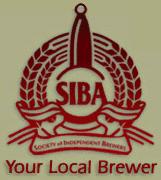 |

|
|

|
|
|
 |

home
about
features
A-Z
books

|

|

features
|

| |
Boom time for Britain's craft brewers
by Willard Clarke, 03/09
Britain�s craft brewers are bucking the trend and reporting an encouraging growth in sales despite the economic downturn, pub closures and a slump in beers produced by global brewers � that is the powerful message from
SIBA, the Society of Independent Brewers.
Its annual Local Brewing Industry Report says its 450 members are investing with confidence for the future as they meet consumer demand for local products. In stark contrast to the decline in sales reported by national and global brewers, the craft brewing sector grew by 10% in 2008. Three per cent was contributed by new brewers who were not operating in 2007, leaving "like for like" volumes up by an impressive 7%.
|
|

|
The British Beer and Pub Association, which represents big brewers and pub companies, paints a different picture for its sector of the industry, with sales in 2008 down by 5.5% on the previous year. In the last quarter of 2008, total sales were down by 8.3% and on-trade pub sales by 9.3%.
The growth of the craft brewery sector has been achieved through increased distribution and increased rate of sale. The throughput of local beers grew by an average of 9% over the past two years. While draught ale in pubs is the mainstay of local brewers, accounting for 86% of volumes, bottled beer sales are growing fast. In 2008, bottled beer volumes increased by more than 50%, which helped to grow total beer sales among craft brewers by an average of 20%.

|
|
SIBA's chief executive Julian Grocock (left) commented: "These are impressive figures that speak volumes for the talent, entrepreneurship and hard work of small brewers throughout Britain. They also demonstrate how the right fiscal support, in the shape of Progressive Beer Duty, can encourage companies not only to thrive but to invest in their future. We applaud the government's commitment to retain PBD and urge them to reconsider other punitive aspects of their taxation policy, which risk causing irreparable damage to the sector."
Beer duty rose by 17.8% in 2008, a record increase that, coupled with the increased cost of ingredients, fuel and utilities, hit the margins of smaller brewers. Forty-five per cent of local brewers saw their gross profits fall last year and only one in eight managed to improve their margins.
|
In spite of these adverse conditions, local brewers have continued to invest, proving that Progressive Beer Duty, introduced seven years ago, is still helping to build thriving small breweries that can contribute to their local economies during the current economic downturn. During 2009, 81% of local brewers plan to invest in new equipment, 82% in marketing and 75% in increasing brewery capacity to meet consumer demand.
The confidence in the sector is underscored by production estimates for 2009, which anticipate growth of 15%. Julian Grocock adds: �Consumers� desire to shop ethically and their willingness to pay a premium to do so are holding firm through the recession. Local beers tick all the boxes for the ethical consumer: genuine provenance, low food miles, sustainable production and contribution to the local economy.�
- The SIBA Local Brewing Industry Report 2009 is based on a survey of close to 200 SIBA members conducted during November and December 2008. Members who took part in the survey were all brewers producing fewer than 30,000 hectolitres a year.
- Progressive Beer Duty (PBD) was introduced in 2002 following a 20-year campaign. Originally it offered relief on duty only to brewers producing up to 30,000 hls but this was extended in 2004 to an upper limit of 60,000 hl.
- HM Revenue & Customs defines a microbrewer as producing up to 5,000 hl a year and a local brewer between 5,000 and 30,000 hl. Above that level,
- a regional brewer produces between 30,000 and 2,000,000 hl and a national brewers in excess of 2,000,000 hl.
addendum
As if to prove this point, The Guardian newspaper published this story on the Hesket Newmarket brewery, just days after the SIBA report:
In praise of ... microbreweries
Sunshine and even the widespread appearance of green shoots, even if they are snowdrops and winter aconites rather than more robust signs of financial recovery. What else do we need to fill the cup of happiness?
Aha, this: Britain 's independent local breweries are bucking every dismal trend. Their share of the beer in the last 12 months has grown by 10%. This is a reward for major work on a minor scale; the perseverance of groups
like the village cooperative in Hesket Newmarket, at the back of Skiddaw in Cumbria, who saved their Old Crown
Inn by opening a brewery in the barn and issuing "village shares".
|
|

|
Locally sourced and low on food miles, such businesses have also proved full of exuberance and marketing flair.
Ethical but not worthy. It is fun to find beers with names such as Doris's 90th Birthday Ale at Hesket or Utopia from the Hog's Back brewery in Sussex , which has clocked up its three-and-a-half-billionth pint
after 17 years. Even teetotallers might permit themselves a sip.
The small beers' success also brings a little spring into the wintry landscape surrounding Britain 's pubs which continue to close at an alarming rate - 36 a week in the autumn and only a little slower now.
Landlords' challenges are many, from the smoking ban to access problems now that drinking, very properly, is no longer acceptable for drivers. But these are insignificant
besides the target-driven regimes of large breweries, the despair of so many tied houses. The micro world is a modest but growing way out.
|
|
home
about
features
A-Z
books
|

